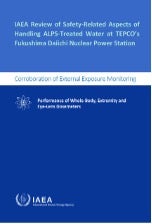
Japan is accurately monitoring occupational radiation exposure of workers involved in handling treated water at the Fukushima Daiichi NPP, according to a new International Atomic Energy Agency (IAEA) report.
IAEA Review of Safety-Related Aspects of Handling ALPS-Treated Water at TEPCO’s Fukushima Daiichi Nuclear Power Station presents findings from the IAEA’s two-year inter-laboratory comparison (ILC) programme, conducted at the request of Japan to verify the accuracy of radiation monitoring services provided by Fukushima NPP operator Tokyo Electric Power Company (Tepco). The work is part of the Agency’s extensive monitoring and assessment activities that support its ongoing safety review of the Advanced Liquid Processing System (ALPS) treated water discharge.
The current approach outlined in the Basic Policy is to conduct a series of controlled discharges of ALPS-treated water into the sea (batch discharges) over a period of decades. Consistent with the relevant IAEA Safety Standards, Tepco bears the responsibility for the protection of workers against occupational exposure to ionising radiation.
The 54-page review focused on confirming external radiation exposure monitoring and evaluating the analytical methods used by relevant dosimetry services. ILCs involve different laboratories separately testing and analysing dosimeters and then comparing results and procedures to determine their reliability and accuracy.
The ILC programme assessed the quality of Tepco’s measurement results from whole-body, extremity and eye-lens dosemeter monitoring. The corroboration work involved IAEA Radiation Safety Technical Services laboratories at the IAEA headquarters in Vienna, Austria, along with laboratories in Japan. Reference metrology laboratories in Germany and Spain supported the ILC by providing reference irradiations in different radiation qualities for the dosimeters.
The key findings of the reported interlaboratory comparisons are that Japanese laboratories have demonstrated a high level of accuracy in their measurements and technical competence. IAEA also found that analytical procedures follow the appropriate methodological standards required to obtain technically valid results. The IAEA notes that these findings provide confidence in Japan’s capability for accurate assessment of external radiation exposure of workers involved in handling ALPS-treated water.
The report concluded: “From an overview of the results presented in the tables and figures showing linearity and angular response, it can be concluded that the interlaboratory comparisons had been successfully carried out without significant problems. This reflects very positively on the work of the organiser, the irradiation laboratories, and the participating individual monitoring services. The proficiency testing scheme provided for an independent demonstration of the reliability and robustness of the dosimetry services involved.”






